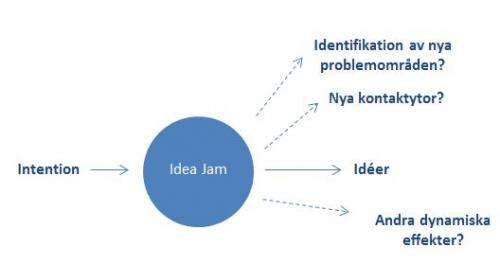Idea jams can boost companies' ability to innovate

Chalmers researcher Anne Elerud-Tryde, who works at the Center for Business Innovation (CBI) research centre, is studying how large companies work on developing new ideas for innovation. How the work of managing ideas is carried out - if there is any sort of system for the idea work, what the driving forces are, and how companies deal with new ideas are some of the questions Anne has studied in nine large businesses. One method that has proved to work for many businesses is carrying out "idea jams".
Idea jams, which are events lasting two to three days where employees produce and discuss ideas together, are popular among several of the companies Anne has studied. The event can be conducted through physical meetings but also in chat forums online, where employees work together to develop prototypes and present ideas to each other for several hours.
"The event is often led by a moderator, who is tasked with finding points in common and asking relevant questions to develop the ideas further. Several companies also conduct creativity workshops and inspirational seminars in connection with their idea jams. During creativity workshops, people usually talk about what being creative involves and perform exercises in how the company works creatively, while inspirational seminars can focus on what innovation is, for example. They then take all their reflections into their idea jam," says Elerud-Tryde.
Practical guidance
In most of the companies she's studied, idea management is a part of more comprehensive work on creating an innovative business culture or developing the company's ability to innovate. The study was carried out on nine large technology-based companies in Sweden, Germany, and the United States. The interviewees are all, or have been, involved in their companies' work with managing ideas.
"I'm trying to show how a company that wants to work with idea management can go about it on a practical level – that is, what can be done and what should be thought about. One example could be conducting idea jams," she says.
Important results
She also hopes to make other effects of idea jams visible – ones that perhaps aren't obvious every time.
"During the interviews, I realised that it doesn't necessarily have to be the new ideas that produce the most benefit for the companies, and it's not certain that this is the only reason for working with idea management. This type of work also opens up new areas of contact within the organisation, which is at least as important for innovation work as the ideas themselves that come out, says Elerud-Tryde.
By pointing out other effects, she hopes that companies will be more aware of what expectations they could have for this type of work, and that the work with ideas is as important for the ability to innovate as the ideas themselves.
In-depth studies
The study is part of a larger research project financed by Vinnova, where Elerud-Tryde works along with her CBI colleagues Sofia Börjesson and Maria Elmquist. Currently, she's sketching out a new article based on her research results.
"I also hope to be able to go further and more in-depth into one or two of the nine companies in order to get better insight into the work on idea management. It's incredibly instructive and interesting to learn how large companies work on producing new ideas," she says.
Provided by Chalmers University of Technology


















